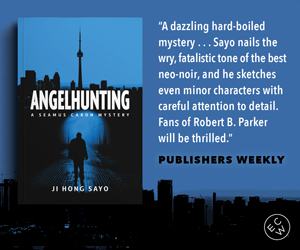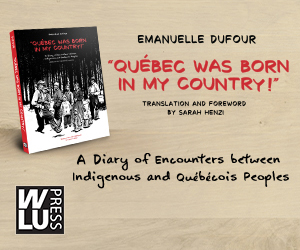Kids Club: Cary Fagan and Milan Pavlovic on The Creative Process Behind Their Gorgeous New Picture Book
The young protagonist of award-winning author Cary Fagan's new picture book Son of Happy (Groundwood) might be the only little boy who doesn't like birthday parties.
Why, you ask? His father, a professional clown named Happy, is always working there. And to make things worse, he's started openly advertising his services on their front lawn.
While he used to love his dad's unique job, he's starting to look at it differently. The red nose, the goofy clothes — it's all so embarrassing.
So, when his father suddenly announces that he will be returning to his former career as a lawyer, the boy is thrilled. With more money and expensive stuff, his family's life seems to be on an upward swing. But even with everything they can now buy, the boy notices his dad doesn't smile as much anymore. Is it possible that they both miss Happy?
Featuring lively and imaginative illustration by Milan Pavlovic, Son of Happy is a sensitive and heartwarming tale about growing up, staying true to yourself, and realizing your parents are human after all.
We're thrilled to have both Cary and Milan at Open Book today to discuss how they began working on their new book, what they absolutely need in order to create, and the importance of fully immersing yourself in your story.
Open Book:
Tell us about your new book and how it came to be.
Cary Fagan:
I was thinking about how kids change so much as they get older, and how that applies to the way they think about their parents. There’s that moment when a mom or dad goes from being your great friend to a bit of an embarrassment you’d like to hide from your friends. Son of Happy follows that change in a manner that I think is both funny and a bit uncomfortable. I was also thinking of a cousin of mine who used to be a professional clown and appeared at kids’ birthday parties. I bet my cousin was a great clown—he’s a warm and friendly guy. But it did occur to me that it must have been a bit weird for his kids as they got older.
Milan Pavlovic:
I got an offer to illustrate Son of Happy from my publisher, Groundwood Books. Since this was not the first time I was illustrating one of Cary Fagan’s stories, I knew that it was going to be exciting and intriguing even before I read the manuscript. It has all trademarks of Cary’s superb writing: it is fun and surprising, masterfully depicting subtle emotional layers, including self-doubt, melancholy and empathy.
Your CanLit News
Subscribe to Open Book’s newsletter to get local book events, literary content, writing tips, and more in your inbox
OB:
Is there a message you hope kids might take away from reading your book?
CF:
I must say that I don’t consciously try to put any message into my kids’ books. My feeling is that kids are being taught all the time by their parents, grandparents, teachers, etc. What I hope is that they will hear or read a book of mine and recognize something true to their own feelings and at the same time be entertained. That being said, I do think that in Son of Happy the boy discovers that his father is a real person with feelings of his own. He discovers an empathy that he didn’t have before. We all need more of that.
OB:
What was the strangest or most memorable moment or experience during the writing process for you?
CF:
Well, I don’t think that I’m always in full control of what’s coming out of my pen (I usually write picture books by hand). And there is at times a melancholy tone to this story that surprised and appeals to me. I think that’s what makes it suitable for the later range of picture book listeners/readers.
MP:
The strangest moment is reading the story for the first time with pencil in hand. The moment when two imaginations meet: one of a writer and one of an illustrator. Carefully trying to capture the mood of the story. Quickly jotting down initial ideas and concepts. Decoding the text visually and identifying particular spots where there is a possibility for illustration to become a visual extension of the text.
OB:
What do you need in order to write – in terms of space, food, rituals, writing instruments?
CF:
I can pretty much write anywhere. I once wrote a picture book on an airplane from Vancouver to Toronto. At home, I write in my attic study, on a narrow, wobbly table that faces a very small window and makes me feel like I’m looking out the porthole of a ship. I also like to write in cafes around my neighbourhood; I can concentrate well with the buzz of strangers around me (plus, the coffee doesn’t hurt.) Right now, of course, we are isolating, so I have to pretend I’m in a café. I have postcard pictures of actual cafes on my wall. I’m not sure if it helps.
MP:
Besides having a quiet space with my art supplies scattered around in seemingly chaotic order, usually I need a set deadline. It keeps me from overthinking, and it reduces my time spent on excessive sketching.
OB:
How do you cope with setbacks or tough points during the writing process? Do you have any strategies that are your go-to responses to difficult points in the process?
CF:
If I have a bad writing day, when I keep checking my email, picking up my mandolin to play a tune, drifting down to the refrigerator, it’s usually because I’m not sure where to go next with the story I’m working on. But I don’t recognize that’s the reason until the next day. Just realizing I need to stop and think helps. The other thing I do is put down a manuscript and switch to another—a kid novel, an adult novel or story. For me, having a few things in progress is a real help.
OB:
Do you feel like there are any misconceptions about writing for young people? What do you wish people knew about what you do?
CF:
Oh, people have lots of misconceptions about writing for kids. I won’t even bother with the obvious ones—that it’s easier to write for kids than adults, etc. But perhaps what they don’t realize is that the author has to want to discover what happens in his story as much as the reader will. Kids’ writers write to escape, to discover, to understand the world, to look inside themselves, to sing in words—just like poets, novelists, and all other writers.
OB:
What's your favourite part of the life cycle of a book? The inspiration, writing the first draft, revision, the editorial relationship, promotion and discussing the book, or something else altogether? What's the toughest part?
MP:
My favourite (and the toughest) part is the process work: sketching and playing around with different drafts, trying to navigate through a pile of drawings, character designs and page compositions. Feeling elated by the way things turned out and then swiftly rejecting it next morning.
OB:
What are you working on now?
MP:
I am working on my new book for Groundwood Books. It is the first book I’ve written (although it is wordless book!) and illustrated. The story is about a strange and improbable friendship between a fish and boy, and their journey through music and imagination. It will be published in Spring 2021.
______________________________________________
Cary Fagan is an award-winning author of books for children and adults. He has won the Vicky Metcalf Award for Children’s Literature, the Jewish Book Award, the IODE Jean Throop Book Award and the Marilyn Baillie Picture Book Award, among others. His many books include the picture book A Cage Went in Search of a Bird, illustrated by Banafsheh Erfanian (“An original and thought-provoking exploration of the rhythms of friendship —Kirkus, starred review) and the short novel The Hollow Under the Tree, an Ontario Library Association Best Bet. Cary lives with his family in Toronto.
Milan Pavlovic lives in Toronto with his family. When he is not illustrating picture books, drawing or playing the ukulele, he is teaching visual communication and illustration at OCAD University and Seneca College. His other books include Moon Wishes by Guy and Patricia Storms, Seamus’s Short Story by Heather Hartt-Sussman (“The illustrations, in rich watercolor and colored pencil, are elegantly patterned —School Library Journal, starred review) and The Snuggly by Glen Huser.





